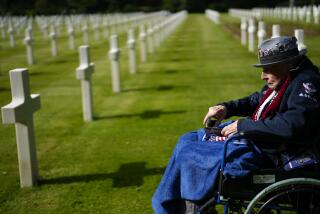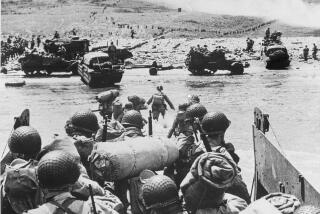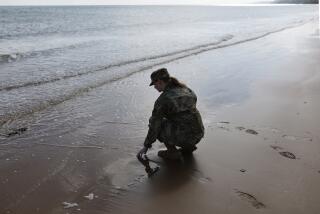Rites Mark Bravery in Defeat at Dutch Bridge : Europe: World War II Allied operation aimed at invading Nazi Germany left British paratroopers stranded.
- Share via
ARNHEM, Netherlands — It was meant to be the most dramatic and successful Allied military operation after D-day, and it was indeed the largest airborne assault in history--involving 35,000 U.S. and British paratroopers.
But 50 years later, in this small Dutch city on the Lower Rhine, survivors and national leaders--including Queen Beatrix of the Netherlands and Britain’s Prince Charles--on Sunday commemorated the valiant efforts of soldiers who suffered one of the worst Allied defeats.
Under rainy skies, they took part in a remembrance at the nearby Oosterbeek Airborne Cemetery where 1,700 bodies of the Arnhem dead lie--some with the headstone “Known Unto God”--those who believed their battle would end the war in Europe by the end of 1944.
As Gen. John Hackett, who commanded a British airborne brigade at Arnhem and was in attendance Sunday, put it: “If we had been able to get the British 2nd Army across the Rhine and into the Ruhr, the war would have been over. At the time, we were much nearer Berlin than the Russians, and if we had got there first, the whole subsequent history of Europe and the Cold War would have been different.”
At the same time Sunday, Dutch military buffs donned World War II U.S. army uniforms and drove a long column of U.S. jeeps and other vintage vehicles from Eindhoven to Nijmegen, about 10 miles south of Arnhem, to honor the American airborne troops.
The Arnhem defeat has been recounted in a dozen books, including the best-selling “A Bridge Too Far” by Cornelius Ryan, which was later made into a popular movie.
The ill-fated operation’s code name was Market Garden, and the plan, devised by British Field Marshal Bernard Montgomery and approved by Supreme Allied Commander Gen. Dwight D. Eisenhower, was to stage airborne landings across bridges in the Netherlands and seize the Arnhem bridge 65 miles from the Allied front lines.
With the bridges in Allied hands, the British 2nd Army would race up the road, crossing the Rhine at Arnhem, in a position then to push east--outflanking Germany’s Ruhr industrial area and halting war production.
In the early part of the operation, the U.S. 101st Airborne Division, under Gen. Maxwell D. Taylor, would drop and take the bridges around Eindhoven, about 40 miles southwest of Arnhem. Simultaneously, the U.S. 82nd Airborne Division, under Gen. James Gavin, would seize two major bridges farther north at Grave and Nijmegen.
The British 1st Airborne Division would jump and land by glider at northernmost Arnhem to capture the big bridge across the Rhine and hold it until British reinforcements from the 2nd Army arrived a couple of days later.
When Montgomery explained the complex plan to British airborne commander Lt. Gen. Frederick (Boy) Browning, the veteran paratrooper suggested, “Sir, I think we might be going a bridge too far.”
For their part of the operation, the Americans performed superbly, securing the key bridges in their sectors and creating makeshift crossings where the Germans blew up bridges.
But the rest of the plan was badly flawed: Browning ignored last-minute photo intelligence and reports from the Dutch Resistance underground that two German SS panzer divisions were in the area.
The Royal Air Force, fearing antiaircraft fire, insisted on dropping paratroopers five to eight miles away from their objective, forcing lightly armed paratroops to fight their way to the bridge.
The air landings were scheduled over two days’ time--thereby giving up surprise and the full weight of the forces in action on the first day.
Further, field radios didn’t work and units were not able to communicate with one another or headquarters.
Perhaps more vitally, Montgomery failed to consider the marshy nature of the wet fields along the highway route the armored columns and infantry would travel: They were basically confined to a single road on which a disabled tank could block a whole column.
As a result, the British division found itself fighting German troops to get to the Arnhem bridge. Only one battalion of the British 1st Airborne--600 men or so--reached the north end of the Arnhem bridge.
The British soldiers held on for five days, fighting under appalling conditions until running out of food, water and, most important, ammunition--waiting in vain for reinforcements to come to their aid.
The failure of the reinforcements to move quickly over bridges cleared by the two U.S. divisions resulted in the eventual surrender of the Arnhem troops: Of about 12,000 British troops who took part, 1,485 were killed in action; 6,525, most of whom were wounded, were captured, and only 3,910 were evacuated by boats across the Rhine on Sept. 25 and 26, l944.
The citizens of Arnhem waited until April 4, 1945, to be liberated by the 1st Canadian Army.
The failure of the planning--and of the ground forces to reach the British troops--still rankles, particularly among the former paratroopers, wearing red berets with silver wings and sporting medals on their blazers, who have thronged this Dutch city for the past few days.
As Gen. Hackett, now 84, who escaped Arnhem and was protected by a Dutch family for five months, put it, “The ground troops could have broken through on the night of Sept. 20, if they had gone hell for leather.”
And Sapper Jack Standen, 78, who was a member of the Royal Engineers attached to the paratroopers and who attended the ceremonies Sunday with his wife, Yvonne, said: “We should never have been there. They should have realized the 2nd Army could not get to us in time.
“I was supposed to keep the Germans from blowing up the bridges, defuse the charges. But I never got to the bridge. Never past headquarters at Oosterbeek. We all wound up defending the perimeter; we were all infantry at the end. I was one of the lucky ones who got out across the river.”
Former airborne Capt. Keith Bell, now 74, who jumped at Arnhem and later went to work as an insurance broker in New York, also reminisced with some bitterness.
Still fit-looking, with a quiet parachute regiment tie, he recalled: “I jumped from my DC-3 Dakota at 500 feet just as it was hit by flak. Ten of my men got out with me; 10 died in the crash of the plane.
“We formed the defensive line at Oosterbeek. I was wounded and, when the evacuation was ordered, tried to escape, but I was captured--and was a POW for the rest of the war until our prison camp was liberated by the Americans on April 12, the same day President (Franklin D.) Roosevelt died.
“We should have landed next to the bridge and took our losses there. It was not well planned. We were eager to go in. We fought well. We were all so young then. And so many dead. I felt a great sadness at the cemetery today.”
If there is a brighter side, according to Hackett it is the firm ties between the British and Dutch.
“What has come out of this tragedy,” he said, “is a friendship which will endure long after all of us have gone. It was not so much a strategic and tactical defeat as a victory for the spirit.”
The Reuters news agency said Dutch police reported Sunday that Hackett was injured in a car accident just after the memorial service at the Oosterbeek cemetery. He was released from a hospital after receiving treatment for minor injuries, but an 82-year-old British veteran in the car was kept overnight after suffering a fracture.
More to Read
Sign up for Essential California
The most important California stories and recommendations in your inbox every morning.
You may occasionally receive promotional content from the Los Angeles Times.










